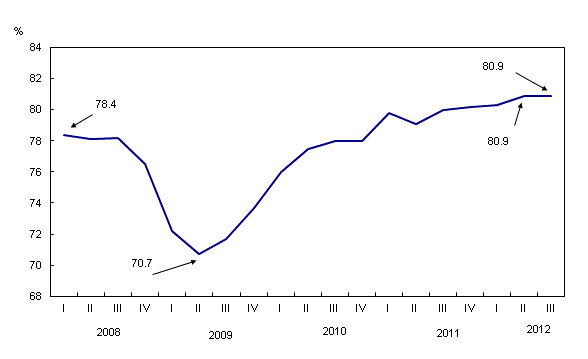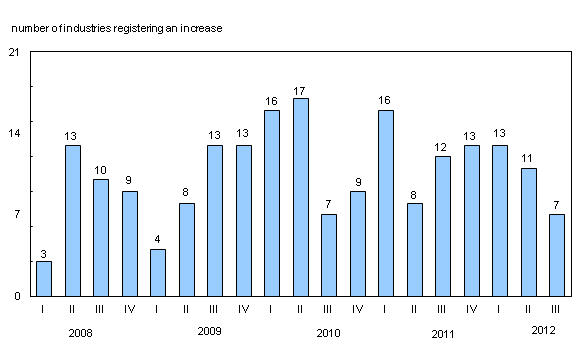Industrial capacity utilization rates, third quarter 2012
Archived Content
Information identified as archived is provided for reference, research or recordkeeping purposes. It is not subject to the Government of Canada Web Standards and has not been altered or updated since it was archived. Please "contact us" to request a format other than those available.
Related subjects
-
[an error occurred while processing this directive]
Canadian industries operated at 80.9% of their production capacity in the third quarter, the same level as in the previous quarter. Both the manufacturing and non-manufacturing sectors remained unchanged.
The third quarter pause came in the wake of four consecutive increases since the third quarter of 2011, ranging from 0.1 to 0.9 percentage points.
Industrial capacity utilization rate levels off

Chart description: Industrial capacity utilization rate levels off
The transportation equipment industry continues to lead the manufacturing sector
Capacity utilization in the manufacturing sector remained unchanged at 81.7% in the third quarter.
The strength of the transportation equipment industry kept the manufacturing sector's capacity utilization rate from declining. Excluding the growth in the transportation equipment industry's capacity use, the manufacturing sector would have decreased 0.2 percentage points in the third quarter.
Capacity utilization rate increases in 7 of the 21 major manufacturing groups

Chart description: Capacity utilization rate increases in 7 of the 21 major manufacturing groups
The capacity utilization rate was up in 7 of the 21 major manufacturing groups in the third quarter. It declined in 13 industries and was unchanged in 1 industry.
The transportation equipment, miscellaneous manufacturing, and beverage and tobacco products manufacturing industries posted increases that had the largest impact on the capacity utilization rate.
As was the case in the previous quarter, higher production of motor vehicles and motor vehicle parts and of aerospace products and their parts raised the capacity utilization rate in the transportation equipment industry. The rate increased from 91.3% in the second quarter to 92.6% in the third quarter.
In the miscellaneous manufacturing industry, capacity use rose from 77.1% in the second quarter to 81.2% in the third quarter. The advance was largely a result of higher production in the medical equipment and supplies manufacturing industry.
Higher output of non-alcoholic beverages was the main factor in the increase of the capacity utilization rate for the beverage and tobacco products manufacturing industry, which rose to 74.8%.
Capacity use decreased in the majority of industries, particularly the printing and related support activities, food and paper industries. The printing and related support activities industry operated at 72.5% of its capacity, down 3.0 percentage points.
The food manufacturing industry operated at 77.6% of its capacity, down 0.6 percentage points. The main reason for the decline was lower production in the seafood product preparation and packaging sector.
Lower output in the converted paper product manufacturing industry reduced the capacity utilization rate in the paper manufacturing industry from 84.6% in the second quarter to 83.5% in the third quarter.
Non-manufacturing industries: Improvement in the electric power generation, transmission and distribution industry
As was the case in the manufacturing industries as a whole, capacity utilization was unchanged in the non-manufacturing sector. There were declines in mining and oil and gas extraction and in forestry and logging. Those decreases were offset by gains in the electric power generation, transmission and distribution industry and the construction industry.
Higher demand for electricity was responsible for the increase in the electric power generation, transmission and distribution industry's capacity use, which rose 1.4 percentage points to 83.9%. The advance came after a decline that began in the third quarter of 2011.
The construction industry remained on an upward trend, as its capacity utilization rate increased from 80.4% in the second quarter to 80.7% in the third quarter. The gain resulted from an increase in residential construction, which was partly counteracted by a decline in non-residential construction.
Capacity use was down in the oil and gas extraction industry, falling from 87.8% in the second quarter to 87.1% in the third quarter. The decline was a result of a decrease in crude oil production, which more than offset the advance in natural gas extraction.
A decrease in metallic and non-metallic mineral extraction more than offset a rise in coal extraction, which lowered capacity utilization in the mining and quarrying industry by 2.6 percentage points. As a result, the industry's capacity utilization rate fell to 58.7%.
Note to readers
The industrial capacity utilization rate is the ratio of an industry's actual output to its estimated potential output. For most industries, the annual estimates are obtained from the Capital and Repair Expenditures Survey while the quarterly pattern is derived from output-to-capital ratio series, the output being the real gross domestic product at basic prices, seasonally adjusted, by industry.
This program covers all manufacturing and selected non-manufacturing industries.
At the time of this release, rates have been revised back to the first quarter of 2009 to reflect updated source data.
Available without charge in CANSIM: table CANSIM table028-0002.
Definitions, data sources and methods: survey number survey number2821.
Data on industrial capacity utilization rates for the fourth quarter of 2012 will be released on March 14, 2013.
For more information, or to enquire about the concepts, methods or data quality of this release, contact us (toll-free 1-800-263-1136; infostats@statcan.gc.ca) or Media Relations (613-951-4636; statcan.mediahotline-ligneinfomedias.statcan@canada.ca).
- Date modified:
